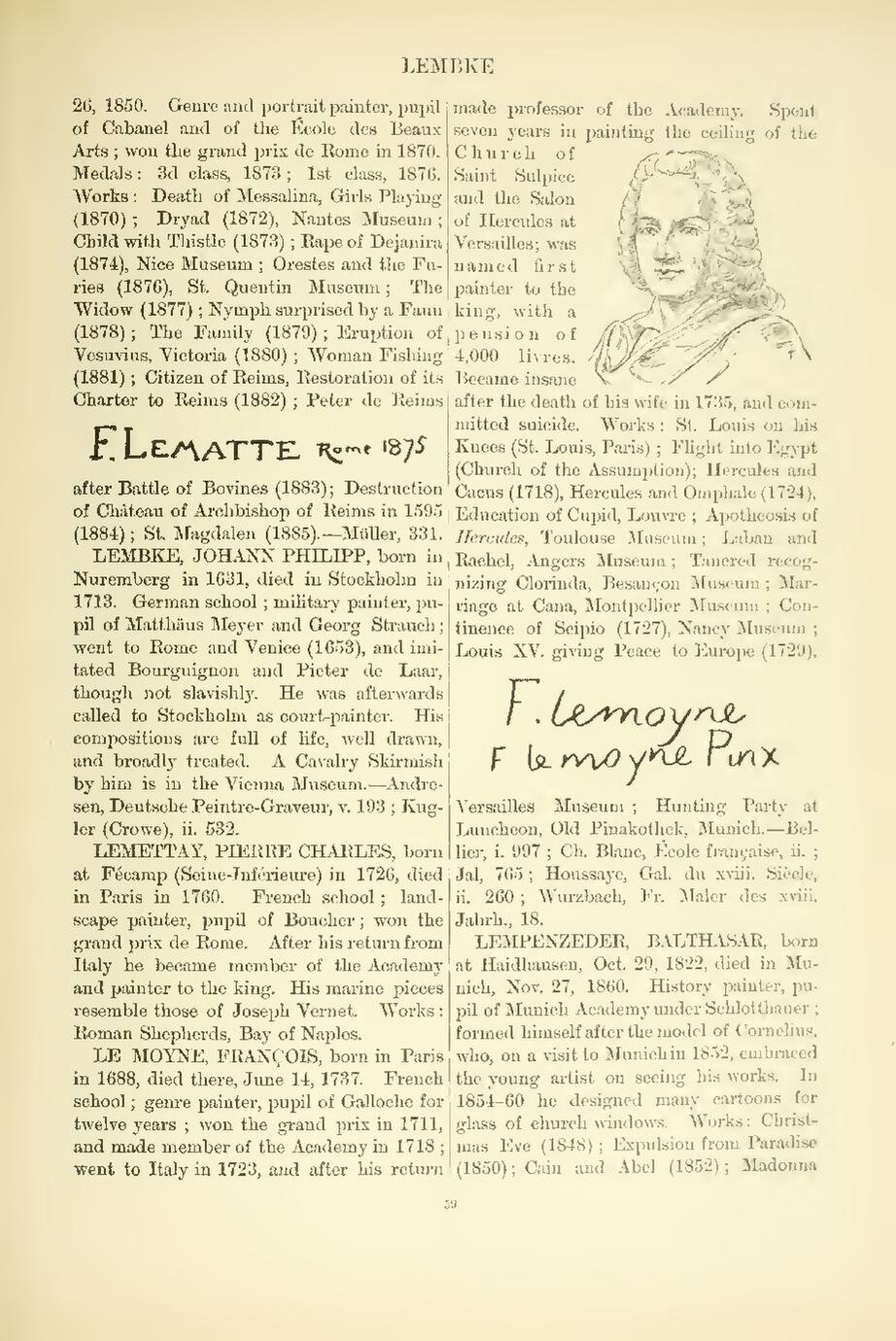26, 1850. Genre and portrait painter, pupil of Cabanel and of the École des Beaux Arts; won the grand prix de Rome in 1870. Medals: 3d class, 1873; 1st class, 1876. Works: Death of Messalina, Girls Playing (1870); Dryad (1872), Nantes Museum; Child with Thistle (1873); Rape of Dejanira (1874), Nice Museum; Orestes and the Furies (1876), St. Quentin Museum; The Widow (1877); Nymph surprised by a Faun (1878); The Family (1879); Eruption of Vesuvius, Victoria (1880); Woman Fishing (1881); Citizen of Reims, Restoration of its Charter to Reims (1882); Peter de Reims after Battle of Bovines (1883); Destruction of Château of Archbishop of Reims in 1595 (1884); St. Magdalen (1885).—Müller, 331.
An image should appear at this position in the text. To use the entire page scan as a placeholder, edit this page and replace "{{missing image}}" with "{{raw image|Cyclopedia of painters and paintings (IA cyclopediaofpain03cham).pdf/81}}". Otherwise, if you are able to provide the image then please do so. For guidance, see Wikisource:Image guidelines and Help:Adding images. |
LEMBKE, JOHANN PHILIPP, born in Nuremberg in 1631, died in Stockholm in 1713. German school; military painter, pupil of Matthäus Meyer and Georg Strauch; went to Rome and Venice (1653), and imitated Bourguignon and Pieter de Laar, though not slavishly. He was afterwards called to Stockholm as court-painter. His compositions are full of life, well drawn, and broadly treated. A Cavalry Skirmish by him is in the Vienna Museum.—Andresen, Deutsche Peintre-Graveur, v. 193; Kugler (Crowe), ii. 532.
LEMETTAY, PIERRE CHARLES, born
at Fécamp (Seine-Inférieure) in 1726, died
in Paris in 1760. French school; landscape
painter, pupil of Boucher; won the
grand prix de Rome. After his return from
Italy he became member of the Academy
and painter to the king. His marine pieces
resemble those of Joseph Vernet. Works:
Roman Shepherds, Bay of Naples.
An image should appear at this position in the text. To use the entire page scan as a placeholder, edit this page and replace "{{missing image}}" with "{{raw image|Cyclopedia of painters and paintings (IA cyclopediaofpain03cham).pdf/81}}". Otherwise, if you are able to provide the image then please do so. For guidance, see Wikisource:Image guidelines and Help:Adding images. |
An image should appear at this position in the text. To use the entire page scan as a placeholder, edit this page and replace "{{missing image}}" with "{{raw image|Cyclopedia of painters and paintings (IA cyclopediaofpain03cham).pdf/81}}". Otherwise, if you are able to provide the image then please do so. For guidance, see Wikisource:Image guidelines and Help:Adding images. |
LE MOYNE, FRANÇOIS, born in Paris
in 1688, died there, June 14, 1737. French
school; genre painter, pupil of Galloche for
twelve years; won the grand prix in 1711,
and made member of the Academy in 1718;
went to Italy in 1723, and after his return
made professor of the Academy. Spent
seven years in painting the ceiling of the
Church of
Saint Sulpice
and the Salon
of Hercules at
Versailles; was
named first
painter to the
king, with a
pension of
4,000 livres.
Became insane
after the death of his wife in 1735, and committed
suicide. Works: St. Louis on his
Knees (St. Louis, Paris); Flight into Egypt
(Church of the Assumption); Hercules and
Cacus (1718), Hercules and Omphale (1724),
Education of Cupid, Louvre; Apotheosis of
Hercules, Toulouse Museum; Laban and
Rachel, Angers Museum; Tancred recognizing
Clorinda, Besançon Museum; Marriage
at Cana, Montpellier Museum; Continence
of Scipio (1727), Nancy Museum;
Louis XV. giving Peace to Europe (1729),
Versailles Museum; Hunting Party at
Luncheon, Old Pinakothek, Munich.—Bellier,
i. 997; Ch. Blanc, École française, ii.;
Jal, 765; Houssaye, Gal. du xviii. Siècle,
ii. 260; Wurzbach, Fr. Maler des xviii.
Jahrh., 18.
LEMPENZEDER, BALTHASAR, born
at Haidhausen, Oct. 29, 1822, died in Munich,
Nov. 27, 1860. History painter, pupil
of Munich Academy under Schlotthauer;
formed himself after the model of Cornelius,
who, on a visit to Munich in 1852, embraced
the young artist on seeing his works. In
1854-60 he designed many cartoons for
glass of church windows. Works: Christmas
Eve (1848); Expulsion from Paradise
(1850); Cain and Abel (1852); Madonna
